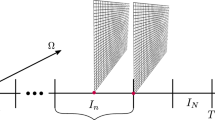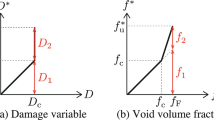Abstract
Many production steps used in the manufacturing of integrated circuits involve the deposition of material from the gas phase onto wafers. Models for these processes should account for gaseous transport in a range of flow regimes, from continuum flow to free molecular or Knudsen flow, and for chemical reactions at the wafer surface. We develop a kinetic transport and reaction model whose mathematical representation is a system of transient linear Boltzmann equations. In addition to time, a deterministic numerical solution of this system of kinetic equations requires the discretization of both position and velocity spaces, each two-dimensional for 2-D/2-D or each three-dimensional for 3-D/3-D simulations. Discretizing the velocity space by a spectral Galerkin method approximates each Boltzmann equation by a system of transient linear hyperbolic conservation laws. The classical choice of basis functions based on Hermite polynomials leads to dense coefficient matrices in this system. We use a collocation basis instead that directly yields diagonal coefficient matrices, allowing for more convenient simulations in higher dimensions. The systems of conservation laws are solved using the discontinuous Galerkin finite element method. First, we simulate chemical vapor deposition in both two and three dimensions in typical micron scale features as application example. Second, stability and convergence of the numerical method are demonstrated numerically in two and three dimensions. Third, we present parallel performance results which indicate that the implementation of the method possesses very good scalability on a distributed-memory cluster with a high-performance Myrinet interconnect.
Similar content being viewed by others
References
Bird, G.A. (1976). Molecular Gas Dynamics, Oxford University Press.
Cale T.S., Bloomfield M.O., Richards D.F., Jansen K.E., Gobbert M.K. (2002). Integrated multiscale process simulation. Comp. Mater. Sci. 23:3–14
Cale T.S., Merchant T.P., Borucki L.J., and Labun A.H. (2000). Topography simulation for the virtual wafer fab. Thin Solid Films 365(2):152–175
Carrillo J.A., Gamba I.M., Majorana A., and Shu C.-W. (2003). A WENO-solver for the transients of Boltzmann–Poisson system for semiconductor devices: Performance and comparisons with Monte Carlo methods. J. Comput. Phys. 184:498–525
Cercignani, C. (1988). The Boltzmann Equation and Its Applications, Vol.67 of Applied Mathematical Sciences. Springer-Verlag.
Cercignani, C. (2000). Rarefied Gas Dynamics: From Basic Concepts to Actual Calculations, Cambridge Texts in Applied Mathematics. Cambridge University Press.
Chorin A.J. (1972). Numerical solution of Boltzmann’s equation. Comm. Pure Appl. Math. 25:171–186
Cockburn, B., Karniadakis, G.E., and Shu, C.-W. (eds.) (2000). Discontinuous Galerkin Methods: Theory, Computation and Applications, Vol.11 of Lecture Notes in Computational Science and Engineering. Springer-Verlag.
Fatemi E., and Odeh F. (1993). Upwind finite difference solution of Boltzmann equation applied to electron transport in semiconductor devices. J. Comput. Phys. 108:209–217
Gobbert, M.K., and Cale, T.S. (2001). A feature scale transport and reaction model for atomic layer deposition. In Swihart, M.T., Allendorf, M.D., and Meyyappan, M. (eds.), Fundamental Gas-Phase and Surface Chemistry of Vapor-Phase Deposition II, volume 2001–13, The Electrochemical Society Proceedings Series pp. 316–323
Gobbert, M.K., and Cale, T.S. (2006). A kinetic transport and reaction model and simulator for rarefied gas flow in the transition regime. J. Comput. Phys. (in press).
Gobbert M.K., Prasad V., and Cale T.S. (2002). Modeling and simulation of atomic layer deposition at the feature scale. J. Vac. Sci. Technol. B 20(3):1031–1043
Gobbert M.K., Prasad V., and Cale T.S. (2002). Predictive modeling of atomic layer deposition on the feature scale. Thin Solid Films 410:129–141
Gobbert M.K., Webster S.G., and Cale T.S. (2002). Transient adsorption and desorption in micrometer scale features. J. Electrochem. Soc. 149(8):G461–G473
Grad H. (1949). On the kinetic theory of rarefied gases. Commun. Pure Appl. Math. 2:331–407
Kersch, A., and Morokoff, W.J. (1995). Transport Simulation in Microelectronics, Vol.3 of Progress in Numerical Simulation for Microelectronics. Birkhäuser Verlag, Basel
Markovich, P.A., Ringhofer, C.A., and Schmeiser, C. (1990). Semiconductor Equations, Springer-Verlag.
Poupaud F. (1991). Diffusion approximation of the linear semiconductor Boltzmann equation: Analysis of boundary layers. Asymptotic Anal. 4:293–317
Reed W.H., and Hill T.R. (1973). Triangular mesh methods for the neutron transport equation. Technical Report LA-UR-73-479, Los Alamos Scientific Laboratory, Los Alamos, NM
Remacle J.-F., Flaherty J.E., and Shephard M.S. (2003). An adaptive discontinuous Galerkin technique with an orthogonal basis applied to compressible flow problems. SIAM Rev. 45(1):53–72
Ringhofer C. (2000). Space–time discretization of series expansion methods for the Boltzmann transport equation. SIAM J. Numer. Anal. 38(2):442–465
Ringhofer C., Schmeiser C., and Zwirchmayr A. (2001). Moment methods for the semiconductor Boltzmann equation on bounded position domains. SIAM J. Numer. Anal. 39(3):1078–1095
Schmeiser C., and Zwirchmayr A. (1998). Convergence of moment methods for linear kinetic equations. SIAM J. Numer. Anal. 36(1):74–88
Webster S.G. (2004). Stability and convergence of a spectral Galerkin method for the linear Boltzmann equation. Ph.D.thesis, University of Maryland, Baltimore County
Webster, S.G., Gobbert, M.K., and Cale, T.S. (2002). Transient 3-D/3-D transport and reactant–wafer interactions: Adsorption and desorption. In Timans, P., Gusev, E., Roozeboom, F., Ozturk, M., and Kwong, D.L. (eds.), Rapid Thermal and Other Short-Time Processing TechnologiesIII, volume 2002–11, The Electrochemical Society Proceedings Series, pp. 81–88
Webster, S.G., Gobbert, M.K., Remacle, J.-F., and Cale, T.S. (2002). Parallel numerical solution of the Boltzmann equation for atomic layer deposition. In Monien, B., and Feldmann, R. (eds.), Euro-Par 2002 Parallel Processing, Vol. 2400 of Lecture Notes in Computer Science, Springer-Verlag, pp. 452–456
Author information
Authors and Affiliations
Corresponding author
Rights and permissions
About this article
Cite this article
Gobbert, M.K., Webster, S.G. & Cale, T.S. A Galerkin Method for the Simulation of the Transient 2-D/2-D and 3-D/3-D Linear Boltzmann Equation. J Sci Comput 30, 237–273 (2007). https://doi.org/10.1007/s10915-005-9069-1
Received:
Accepted:
Published:
Issue Date:
DOI: https://doi.org/10.1007/s10915-005-9069-1




